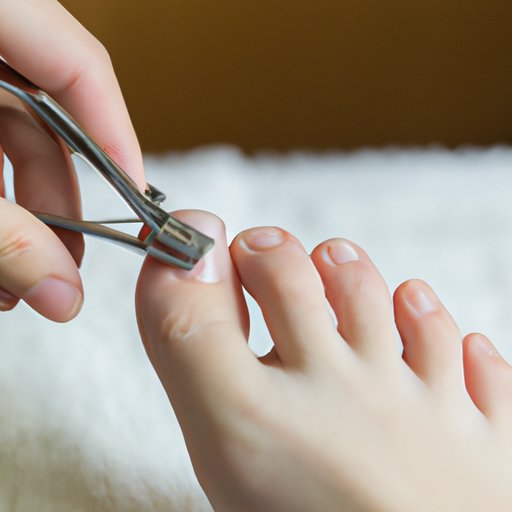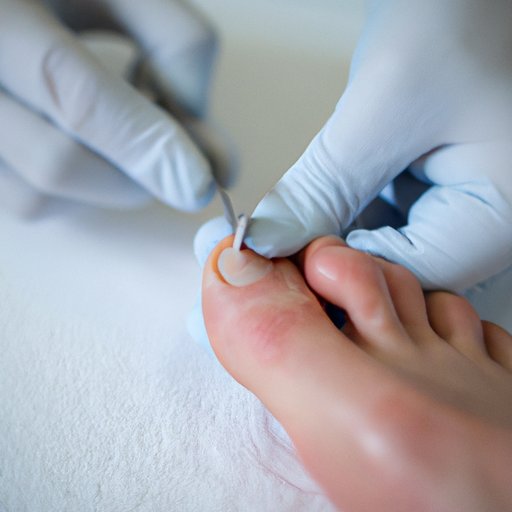
Introduction
Ingrown toenail, also known as onychocryptosis, is a common condition where the edge of the nail grows into the skin, causing pain, swelling, and redness. This condition mainly affects the big toe, but it can occur on any toe. While it is not a serious medical issue, it can be uncomfortable and lead to complications if left untreated. In this article, we will explore home remedies, prevention, and treatment options for curing ingrown toenail.
Home Remedies for Curing Ingrown Toenail
If you’re experiencing mild symptoms of ingrown toenail, there are some home remedies you can try:
Soak your Feet in Warm Water and Salt
Soaking your feet in warm water and salt can help reduce swelling, relieve pain, and soften the skin around the ingrown nail. Fill a basin with warm water and add 1-2 tablespoons of Epsom salt or regular salt. Soak your feet for 15-20 minutes, two to three times a day.
Use a Small Cotton Ball to Insert between the Nail and Skin to Lift the Nail
Using a small cotton ball to lift the nail can provide relief by raising the nail and preventing it from growing into the skin. To do this, gently lift the edge of the ingrown nail with a pair of tweezers or a clean fingernail, and insert a small piece of cotton ball between the nail and the skin. Change the cotton ball at least once a day.
Apply Antibiotic Ointment
Applying over-the-counter antibiotic ointment, such as Neosporin or Bacitracin, can help prevent infection and reduce inflammation. Apply a small amount of ointment on the affected area, cover it with a bandage, and leave it overnight. Repeat this process until the symptoms improve.
Use Proper Toenail Cutting Techniques
Improper cutting of toenails is one of the main causes of ingrown toenail. Always cut your toenails straight across and avoid rounding the edges, as this can cause the nail to grow into the skin. Use proper toenail clippers and avoid trimming nails too short.
How to Prevent Ingrown Toenail Growth
Preventing ingrown toenail growth is the best way to avoid the condition altogether. Here are a few tips to follow:
Cut Toenails Straight Across
As mentioned earlier, cutting toenails straight across can help prevent the nail from growing into the skin. Avoid cutting them too short, and keep them at moderate length.
Trim Toenails Regularly
Trimming your toenails regularly can help prevent them from becoming too long and curling under. Aim to trim them every two to three weeks.
Wear Shoes that Fit Properly
Wearing shoes that fit properly can help avoid pressure and avoid ingrown toenails. Make sure there is enough room in the toe box, and avoid shoes that are too tight or narrow.
Don’t Wear Tight Hosiery or Socks
Tight hosiery or socks can put pressure on your toes, causing the nail to grow into the skin. Wear well-fitted socks that allow your toes to move freely.
Keep Feet Clean and Dry
Keeping your feet clean and dry is essential to maintaining good foot hygiene. Make sure to wash your feet every day, and dry them thoroughly, especially in between the toes.
Over-the-Counter Medications for Treating Ingrown Toenail
If home remedies do not provide relief, you can try over-the-counter medications. Here are some of the most effective ones:
Pain Relievers
Over-the-counter pain relievers, such as acetaminophen and ibuprofen, can help alleviate pain and inflammation associated with ingrown toenail. Follow the instructions on the package to avoid any side effects.
Antibiotic Ointments
Topical antibiotic ointments can help prevent infection and reduce inflammation. Apply a small amount of ointment on the affected area, cover it with a bandage, and leave it overnight. Repeat this process until the symptoms improve.
Topical Gels
Topical gels, such as Lidocaine, can help numb the affected area, providing pain relief. Apply a small amount of gel on the affected area and leave it to dry.

Surgical Treatment for Severe Ingrown Toenail Condition
If your ingrown toenail is severe or has become infected, you may need surgical treatment. The procedure involves removing a portion of the nail or the nail bed to allow the toe to heal. Your doctor will provide pain relief and advise you on post-operative care.
Procedure Explanation
The procedure for treating an ingrown toenail involves numbing the toe with a local anesthetic, cutting away the ingrown portion of the nail, and removing the affected nail bed tissue.
Recovery Process
After the procedure, you will need to keep your foot dry and elevated for several days. Your doctor may prescribe painkillers and antibiotics to prevent infection. You can typically return to normal activities within a week or two.
The Importance of Wearing Proper Footwear to Avoid Ingrown Toenail Issues
Wearing the right type of shoes can greatly reduce the risk of developing ingrown toenail. Here are some footwear options that promote good foot health:
Athletic Shoes with Enough Room in the Toe Box
Athletic shoes with good arch support and enough room in the toe box can help keep your feet healthy and pain-free.
Open-Toed Shoes
Wearing open-toed shoes can help reduce pressure on the toes and prevent ingrown toenail from occurring.
Shoes Made of Breathable Material
Shoes made of breathable materials, such as leather or canvas, can help keep your feet dry and prevent fungal infections that can lead to ingrown toenail.
How to Cut Your Toenails to Prevent Ingrown Toenails
Learning how to properly cut your toenails can help prevent ingrown toenail growth. Follow these steps:
Technique Explanation
Using proper toenail clippers, cut your toenails straight across. Avoid rounding the edges, and do not cut them too short. Make sure to smooth out rough edges with a file or emery board.
Tool Recommendation
Use toenail clippers specifically designed for toenails, as using regular fingernail clippers can put too much pressure on the nail.
When to See a Doctor for Ingrown Toenail and What to Expect
If the symptoms of ingrown toenail persist, you should see a doctor. Here are some symptoms that require medical attention:
- Persistent foot pain or redness
- Swelling or tenderness in the toe
- Pus or drainage coming from the affected area
- Fever
- Bone fracture or suspected bone infection in the toe.
Your doctor may perform a physical exam of the affected area and recommend various treatment options, such as surgical removal of the nail bed or antibiotics. They will provide you with instructions on how to care for your affected toe and advise you on how to prevent future ingrown toenail.
Conclusion
Ingrown toenail can be a painful and uncomfortable condition. Fortunately, there are many home remedies and preventive measures you can take to avoid the condition from occurring. If the symptoms persist, you should contact a doctor for medical treatment. By following the tips and remedies discussed in this article, you can successfully cure ingrown toenail and protect your foot health.




